Avalon Beach SLSC During World War Two: The Police Boys Club Mans the Beaches - VP Day 2025
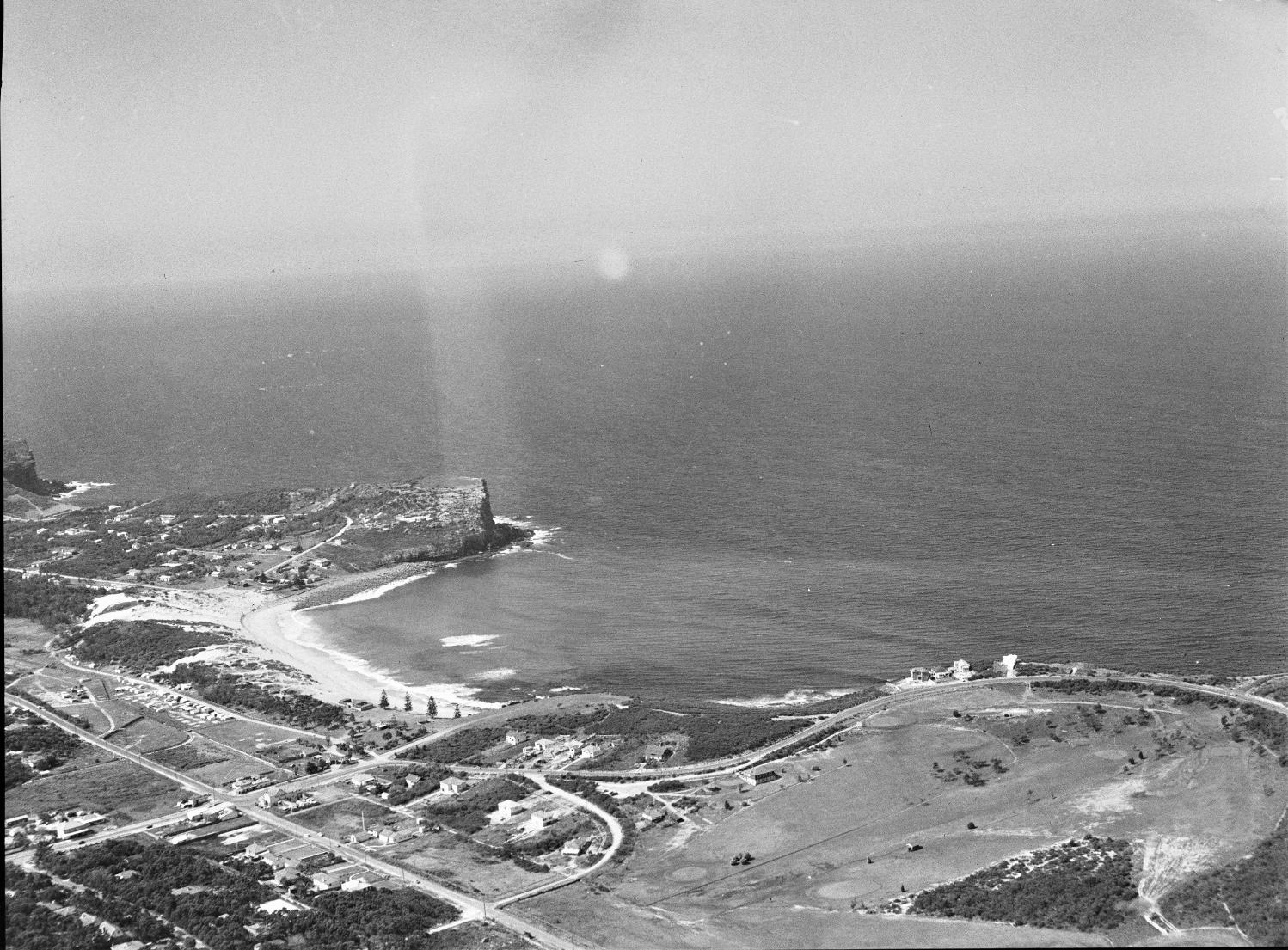
Avalon [From the air], 1949, Item e23711_0001_c, courtesy Mitchell Library, State Library of New South Wales, where you can see Norfolk pines along the southern beachfront that must have been 4-5 years of age by then
Victory in the Pacific (VP) Day in 2025 was commemorated on Friday, August 15th in 2025, and marked the 80th anniversary of Japan's surrender to the Allied forces in 1945. This day signifies the end of World War II in the Pacific and is a time for Australians to remember and honour the service and sacrifice of all those who served in this conflict, and particularly in the Pacific.
A combined Sub-Branches VP Day Commemoration Service was held at the Avalon Beach RSL Cenotaph, led by Vice President Tamara Sloper-Harding, OAM.
See: VP Day 80 Years On - Our Area Remembers, Honours Those Who Served
This RSL did not exist during this conflict, however, over on Avalon Beach itself, teenagers who had been a part of the Woolloomooloo Police Boys Club were looking after the masses of people who returned to the water once it became apparent it was safe to do so.
As the fourth and final VP Day 80th Commemorative Service tribute, a few insights from two of those boys and how the Woolloomooloo Police Boys Clubs' members became involved in serving on the beaches.
From Mona Vale north to Palm Beach, those who had served as active patrol members signed up to serve.
the young stepped up during this time to do what they could to help out. On Mona Vale beach future film star Rod Taylor, who later lived in the so-called 'Mad Mile' group of artists who lived in and around Waterview Street Mona Vale, was one of those youngsters. Bruce Robertson OAM, during his interview for a Profile shared:
Through talking to Rod Taylor, later a well-known Australian actor, when we were wrapping papers, we’d talk about what we were doing. He was doing art at Sydney Technical College and I was still at school. We used to wrap all the newspapers and periodicals for Swains, which was a big stationer in Pitt Street in Sydney. This was in 1941 and 1942, I was 11 and 12.
We were both keen on the surf and said one day ‘let’s have a look’. So we decided we’d get the bus where we could, caught a bus and went as far as the bus would go which was Mona Vale. We walked down to the beach and that was it.
About 14 or 15 of us used to sleep on a big wrestling mat in the middle of the floor. The clubhouse had gone up three or four years prior to that.
During the war I was a messenger boy for the Air Raid organisation at Roseville. This was exciting work. I must admit I was never frightened of the Japanese, I didn’t think they could really get here (to Sydney) but at the same time, that’s exactly what was happening.
[On the night of 31 May-1 June 1942, three Ko-hyoteki class midget submarines of the Imperial Japanese Navy entered Sydney Harbour to attack Allied warships. One was found, decades later, off Bungan-Newport beaches.]
What happened at Mona Vale Beach in terms of preparation was one clear example of this. They had an enormous barricade of barbed wire set there.To prevent or stall a feared invasion by Japanese forces, a tank trap was built across the course from Turrimetta to Mona Vale heads and barbed wire entanglements erected next to the beach. An influx of defence forces meant La Corniche was utilised while Mona Vale Golf Club's clubhouse was commandeered for use as administration offices and officers’ mess for the nearby army camp.I must say though that during the war there were other hazards causing problems, namely the amount of barbed wire placed there as a deterrent against any potential invasion. They had captured plans you see, plans made by the Japanese to use tanks in an invasion right along our coasts and so tank traps and barbed wire were installed. Every beach had these big concrete triangles, the waterways at Pittwater had them too.We all had to go in and out of these. To go to the surf at Mona Vale during the war you went through two ‘S’s going round and in and out and then in and out again and add to these a series of barbed wire. My main activity then was giving First Aid to people and applying ointments and washing out sand from cuts from barbed wire.
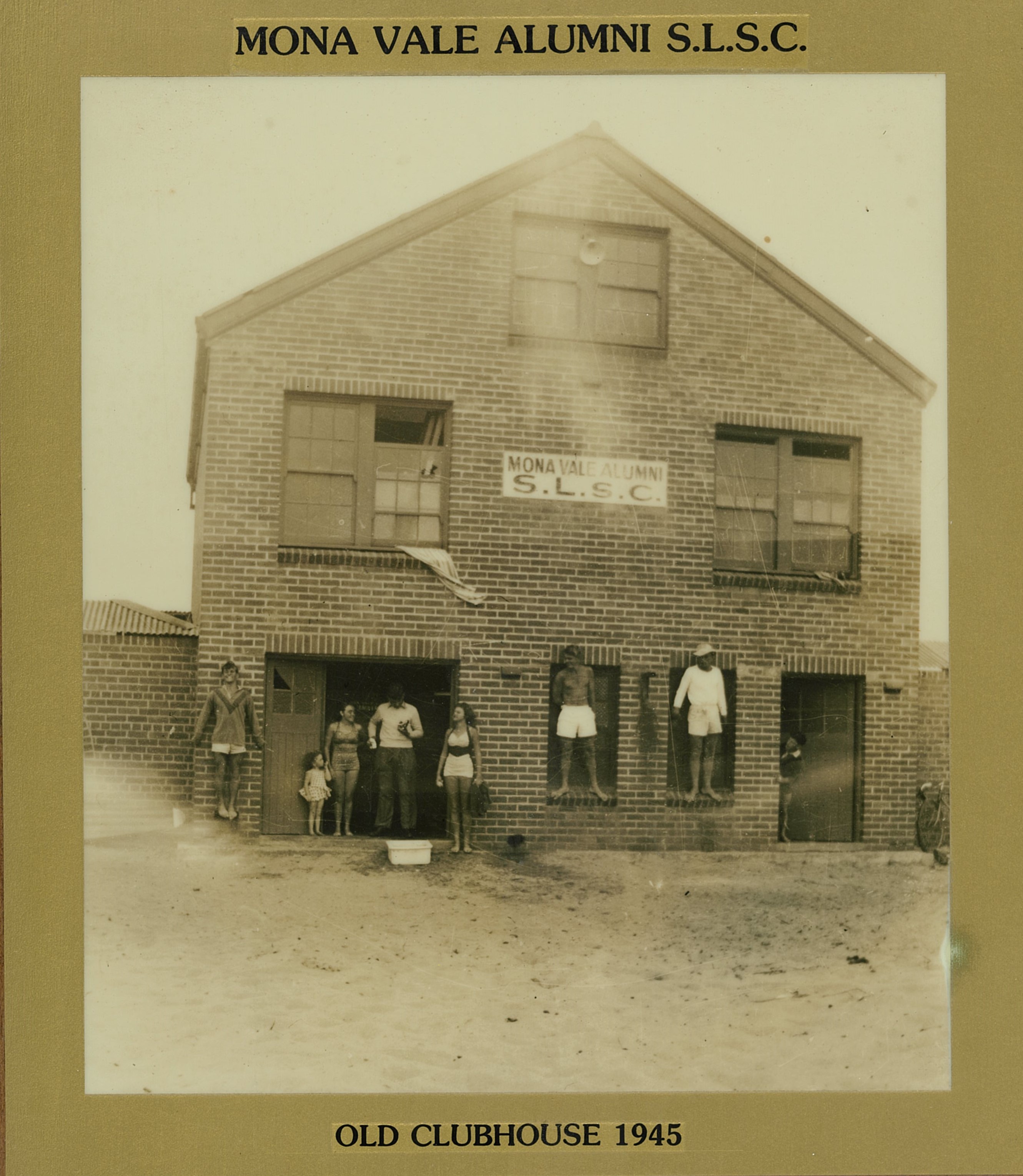
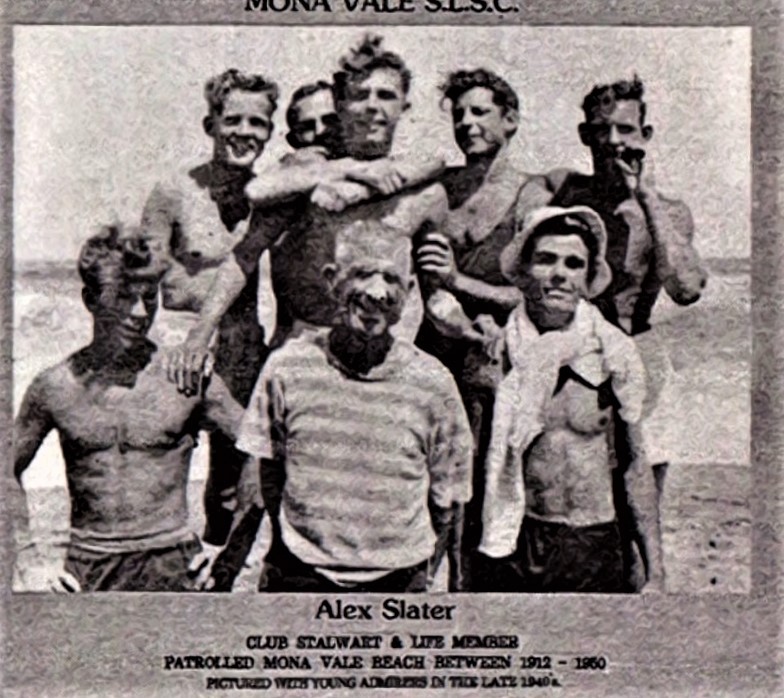
- Harold Kerslake: State welterweight Novice wrestling champion, 1941-2. Federation Police Boys' Clubs Middleweight champion, 1941-2.
- Leo Sweeny: Light - heavyweight wrestling champion of the Federation of Police Boys' Clubs, 1941-2.
- Edward Dash: State novice middleweight wrestling champion, 1941-2
- Dean Armytage: Former prominent bike rider and the middleweight boxing champion of the Federation.
- Clarrie Volz: Played grade football with Smith Sydney. 1939-40-41.
- H. Wilkins: State novice featherweight wrestling champion, 1940-41.
- B. Harris: State novice flyweight wrestling champion, 1941-2; Federation featherweight champion, 1940-41-42.
- Pat Petty: One of Australia's foremost exponents in punching ball displays. Only 16 years of age.
- Mervyn Dash: Prominent in the League of Wheelmens' Juvenile championship, 1941-2.
- Jack Hill: (No record).
- William Grenfell: Jib-hand on the "J L Glick" 18'-footer that races with the Sydney Flying Squadron.
- Donald Duff: Represented N.S.W. in the Interstate Amateur Boxing Tourney, 1941 and was presented with a trophy for being best boxer in tournament. He won the flyweight division of the N.S.W. Open Championship boxing in 1940 Runner-up in State title (flyweight) 1941; won tournaments conducted at Chats-wood, Waverley, Lidcombe and Earlwood
- Lloyd Modra: Winner welterweight division of the Federation, 1941 (wrestling). BOYS' CLUBS (1941, October 28). Daily Mirror (Sydney, NSW : 1941 - 1955), p. 19 (War News Edition). Retrieved from http://nla.gov.au/nla.news-article271427813
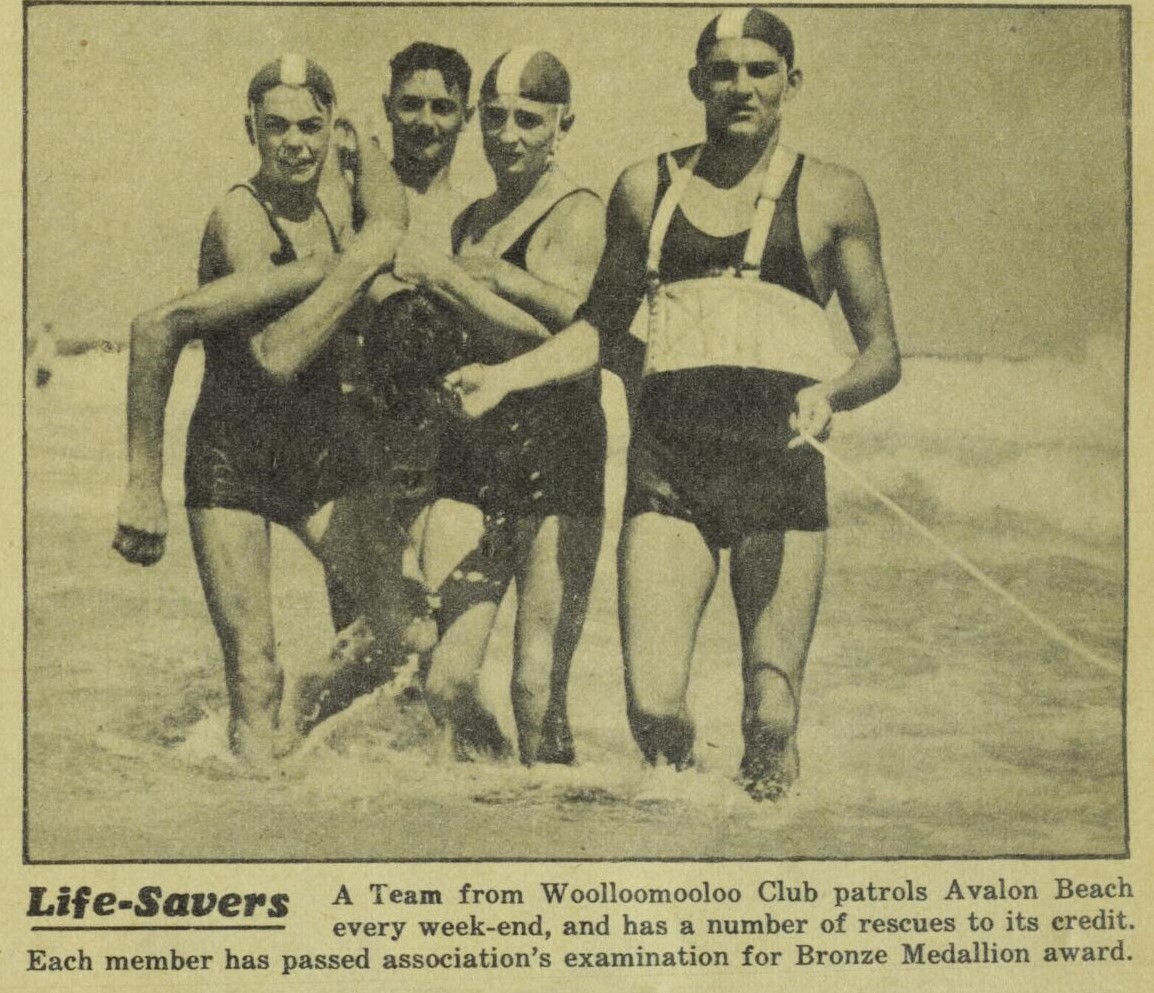
You first came to Avalon from the Woolloomooloo Police Boys Club club in 1944?
Yes, that’s correct. During the war there was only one life saver left at Avalon and the association got in touch with Leichardt and the Woolloomooloo Boy’s Clubs to see if they could get members to man the beach. Which they did. I was in attendance down there – I was in the wrestling class at Woolloomooloo, and about four other members of the class were members of the club.
So you knew Doug Crane?
Yes – Doug came later – he was a Naval Architect with the Navy.
How did you get there?
Well, it was difficult. I lived at Abbotsford, and we had to get the tram to Wynyard, then the tram from Wynyard to the Spit and then the bus to Avalon, with a couple of stops at Narrabeen. That was the original start. Later on they bought us an old Packard – you know, one of the old Packard’s with the dickie seat. They used to house it near the railway there. What would happen then is we’d all turn up and you’d get three big blokes in the front, they’d put the dickie seats down and put cushions in there with the kit bags and get four in there as well, and then they’d be four in the back seat, with one laying along. So that was the crowd that we used to get. That was alright for a while but if you missed out on that then you had to get the bus.
Did you stay there all weekend?
Sometimes. We would try to get down for the weekend. Most of the years we spent Christmas down there too; summer and winter we still went down there. It was quite a lifestyle as you can imagine – the only trouble was the eating down there because in those days there were very few shops. About half past five the shops would shut and you could shoot a gun down the street it was that quiet. There was nothing – there was LeClerc’s on one corner, McDonald’s on the opposite corner then A J Small used to have a little box seat where he used to deal Real Estate and then the other side was Parsonage the Butchers, then Wilco’s the fruit shop and Mrs. Thornton with her meat pies. She ran a cake shop – we used to love her meat pies, that’s what we lived on over the weekend – milk shakes and meat pies.
Later on we thought 'what are we going to do here?' – so we decided we’d try and cook our own food. So we got two primuses and a couple of medium dishes and everyone brought a tin of food of some sort. We bought a loaf of bread and half a pound of butter and potatoes. So we made the potatoes – boiled them, put butter into them, the rest of the butter we’d use for the bread, and then we got six people, six loaves of bread, and then we’d put all the tins in together – spaghetti, sausages – everything went into one big bowl. You’d sit down and eat this with your slices of bread. Thinking back now it was a shocker but in those days it was beautiful food, especially when you’re tired and hungry.
Were there many people still going to the beach then?
There was a chap called Ruskin Rowe, a big architect down there, and he had a lot of land down there – most people would know what has been named after him – Ruskin Rowe. He was a big chap, great big chap, we used to see him of a morning in white shorts, a white sailcloth hat with the side turned up, and he had a great big Cadillac – he used to go down to the milk shop at Wilco’s with this little tiny bloody milk can and get his milk. It looked so funny, this huge man getting out of his car with this little can getting his milk (laughs). He was a huge man, nice man, well spoken. At any rate, he used to go up there to his land, he had all this land there and during the war he had the Air Force Cadets in – he used to get up there with a big scythe and get them to use the scythe going all over the grounds.
The Air Force Cadets would be down at Avalon for the weekend and they would march down to the beach and then they’d all go into the water. They were pretty regimented - we’d watch them march down and go back again. We knew we’d have trouble when they came down to the beach though – would say to each other ‘here they are, watch ‘em,’ – you had to watch them like hawks because some of the young scrubs were from the country and they didn’t know how to swim.
Down on the beach they’d only be about fifty people I suppose – but enough to get into trouble, as you can probably imagine – it’s a funny beach, Avalon, there’s a few spots there where people can get into trouble.
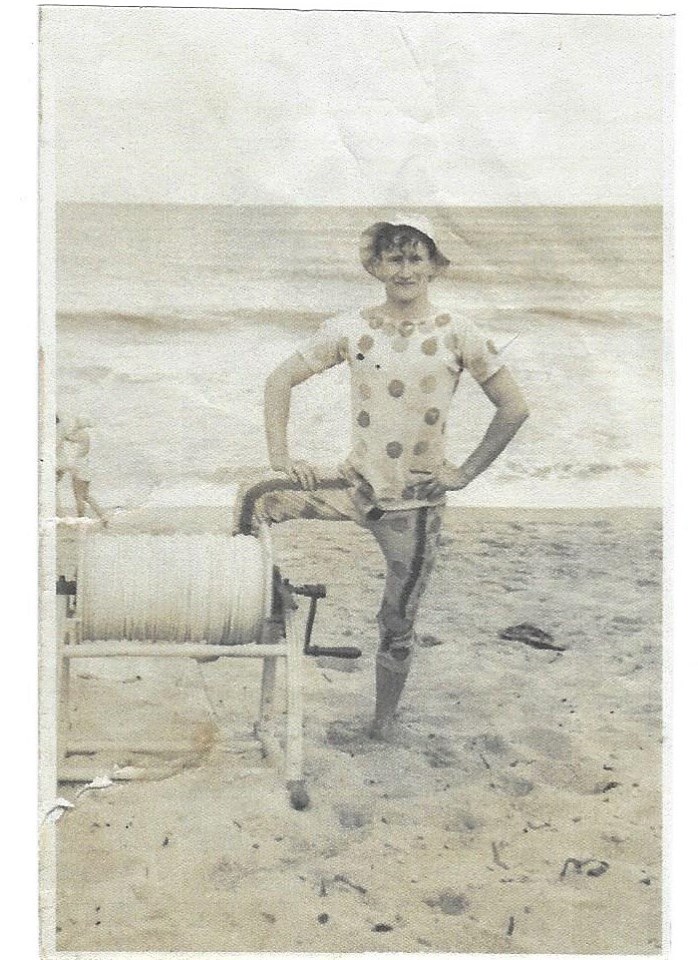
AIR TRAINING CORPS CAMP AT AVALON OPENED. The R.A.A.F. Air Training Corps camp at Avalon was opened yesterday by Group-Captain W. H. Robertson, Commanding Officer for Australia of the A.T.C. The cadets receive preliminary training at the camp to prepare them for their entry into the Air Force at the age of 18. Left: Pilot-Officer Wadds', D.F.C., Group-Captain Ellis, and Group Captain Robertson with an A.T.C. corporal in the camp kitchen. Right: Rear-Admiral Muirhead-Gould speaking at the opening of the camp, which is the first of its type in Australia. AIR TRAINING CORPS CAMP AT AVALON OPENED. (1943, March 22). The Sydney Morning Herald (NSW : 1842 - 1954), p. 6. Retrieved from http://nla.gov.au/nla.news-article17841433
What were you using to rescue people?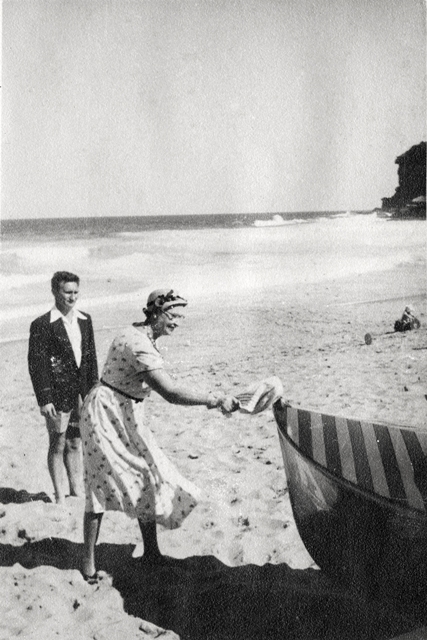 In those days we only had one surfboard – it was made out of half inch timber, so you can imagine how heavy it was. We never used it that much. Most of it was belt, line and reel. We had a surfboat – one was donated by a bloke called Geoff Groven – and we got another one from a Scotsman down there; he gave us one and he named it Ready-Aye-Ready – he did the presentation down in the local theatre.
In those days we only had one surfboard – it was made out of half inch timber, so you can imagine how heavy it was. We never used it that much. Most of it was belt, line and reel. We had a surfboat – one was donated by a bloke called Geoff Groven – and we got another one from a Scotsman down there; he gave us one and he named it Ready-Aye-Ready – he did the presentation down in the local theatre.
We were pretty public spirited down there – one of the chaps was Fred Andrews – he was in the Fire Brigade and often when he was down there he fought a few bushfires. Up where the Catholic Church is now, they had a bit of a fire up there and he called down to the boys on patrol and they went up there to help fight the bloody fire.
We ended up one night, Norman Cook, he was a decent bloke, a good bloke, one of the members of the club still now actually, he had something to do with the theatre – the school wanted to put a special night on, a fundraiser, and he got four or five people from the ballet came down – there was a Russian bloke there who had legs on him like tree stumps – geez he was a big man, anyway he conned another chap in the club called Ian Gorrie and I; we were doing judo at present in the Kano club down near the Glaciarium ( Sydney) and he said ‘we want you to do a display’ – at any rate, we had to do these damn throws on three blankets – that’s all we could use for a mat, we didn’t break anything but our arms later on….they were funny old days down there.
GLACIARIUM: POPULAR NIGHT ICE SKATING. Open Today 3 pm and 8 pm POPULAR NIGHT TO NIGHT Admission 1/3 (including tax) Skate Hire 1/4 ... B Season closes Jan 13 Sydney s favourite pastime in off duty hours Phone NiABOBl. GLACIARIUM ICE RINK RAILWAY SQUARE, SYDNEY. Advertising. (1945, January 1). The Sydney Morning Herald(NSW : 1842 - 1954), p. 5. Retrieved from http://nla.gov.au/nla.news-article17935885
So you kept going to Avalon after the war?
Oh yes. I was down there, in every billeting down there – I was club Captain, Vice Captain, Assistant Secretary, Board Captain, Social Secretary, Judiciary Committees – I was a delegate down there for about 30 years – Life Membership for 22 years for different bits and pieces, it was going very well.
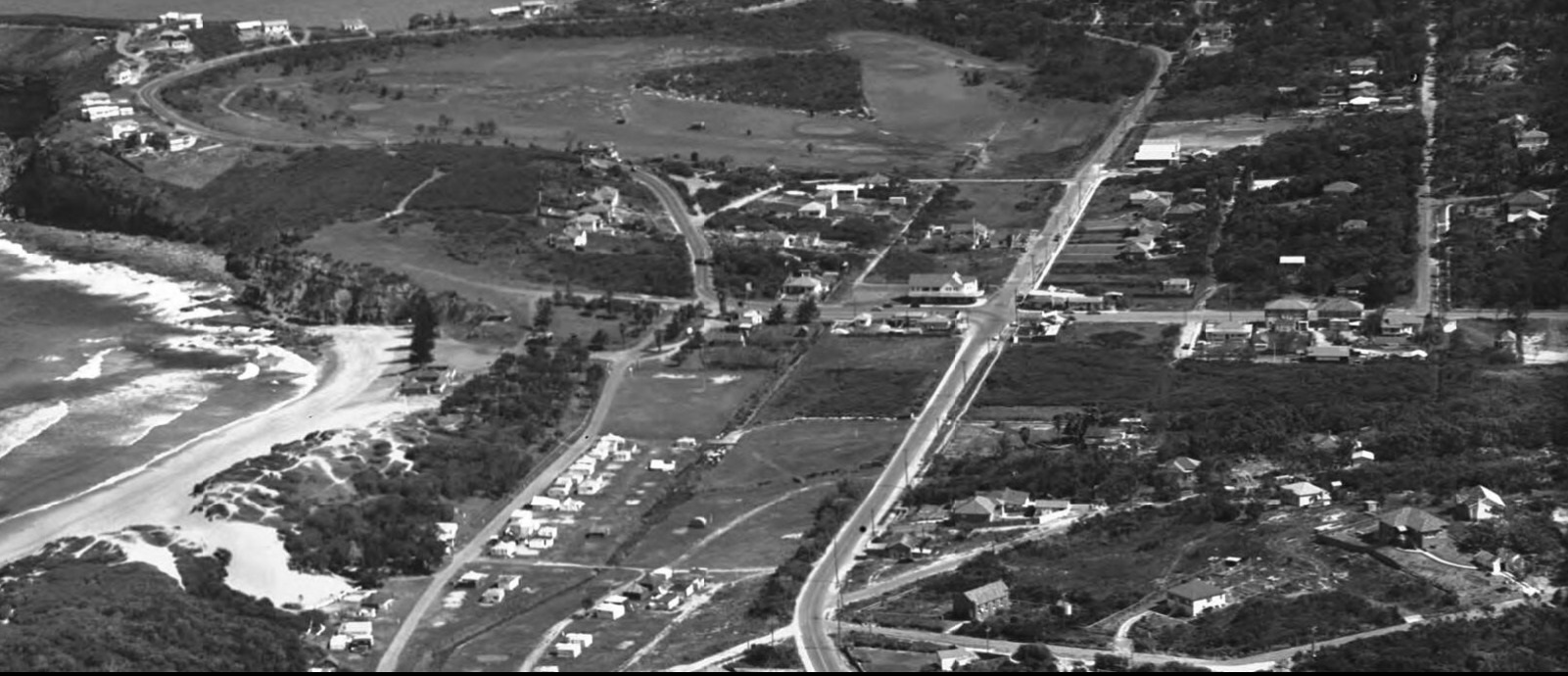
Hurley, Frank. Avalon Beach & surroundings [Aerial views, Sydney, New South Wales] circa 1950-52 (enlarged section from to show camping ground alongside Careel Creek and surrounds - including the Norfolk pines on south end of beach; 4 can be seen and the tip of a 5th one right at the southern edge, tucked behind the bank rise) Retrieved from http://nla.gov.au/nla.obj-160005527
Doug Crane first started coming to Avalon to be on Patrol during 1944 at the age of 18. Doug is of the generation that came of age during World War Two. Everyone was involved in fighting this war in one form or another and this week Doug shared some insights on those times and how those too young to fight or already employed in ‘reserved occupations’. Doug, serving an apprenticeship at Garden Island Dockyards, became involved in the Woolloomooloo Police Boys Club. One of their trainers, a policeman from Avalon, among other locals, was concerned about those at risk in the surf:
Doug explained during his Profile interview:
It was towards the end of the war. You see there’s a little story about the Club’s history for war-time. At the outbreak of WWII all the guys here gradually signed up and they left everyone here (on the beach) without anyone to look after them. And it’s a bit toey on the beach, you’ve got to be careful, a lot of people have ‘gone to sea’, and been rescued, they’ve been lucky. At that stage they were getting a bit worried about; ‘who’s going to help them out of the surf?’, the locals, and it so happened there was a policeman who lived here, who was connected to the Police Boys Club at Woolloomooloo and when the word went out that things were a bit hairy here, he said ‘Oh I think I can help you there, I might be able to train some of you blokes’. I lived in Willoughby and I had to go to the city daily for my own benefit and it wasn’t a difficult business to stay on a bit longer and do a Course that they churned out. A lot of the guys that were then available became members.
Of course once they got their Bronze Medallion they were full members, and several of them that were at the Woolloomooloo Police Boys Club which gave the existing club a little bit of a come on so that they weren’t lost in the quagmire of the war or the desert (afterwards) but there were enough people to get the club cranked up to run again. The club (PYC)was disbanded for 3 or 4 years, back in WWII, at the end of it, until about (’48 or ’49). So relations with the locals took a bit of a turn towards combined sense, and the guys here realised they were trying to do something about their welfare and they supported it. It was still the same old box (shed) though. It was just a hut for change rooms. It was only cold water in the showers.
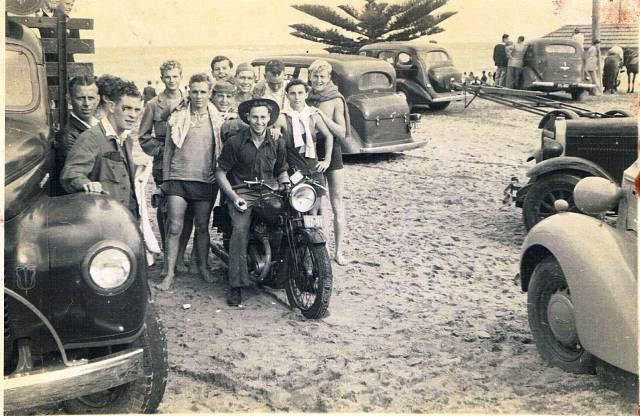
Above: Doug on his bike at Avalon, aged 18, 1944 with mate Max Watt beside him.
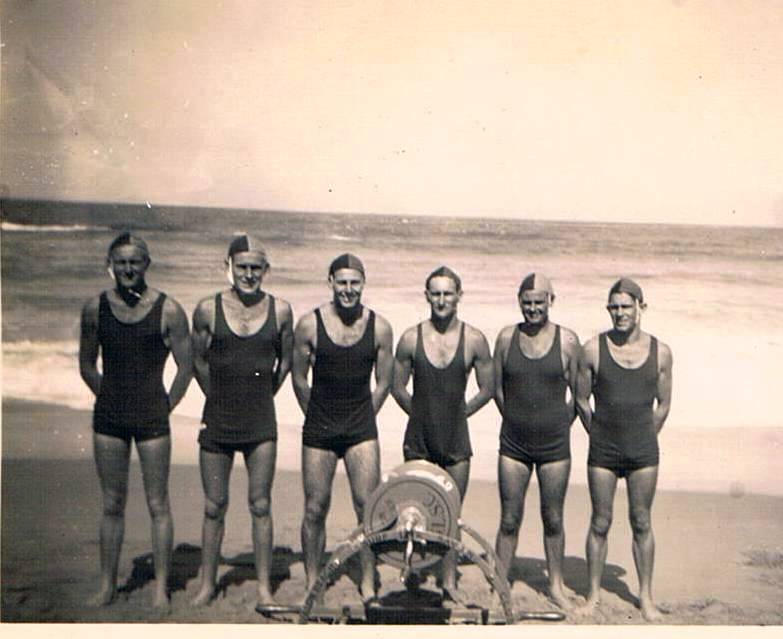
Above and below: Doug and his mates 1946-48 - Doug is 3rd from left (above).
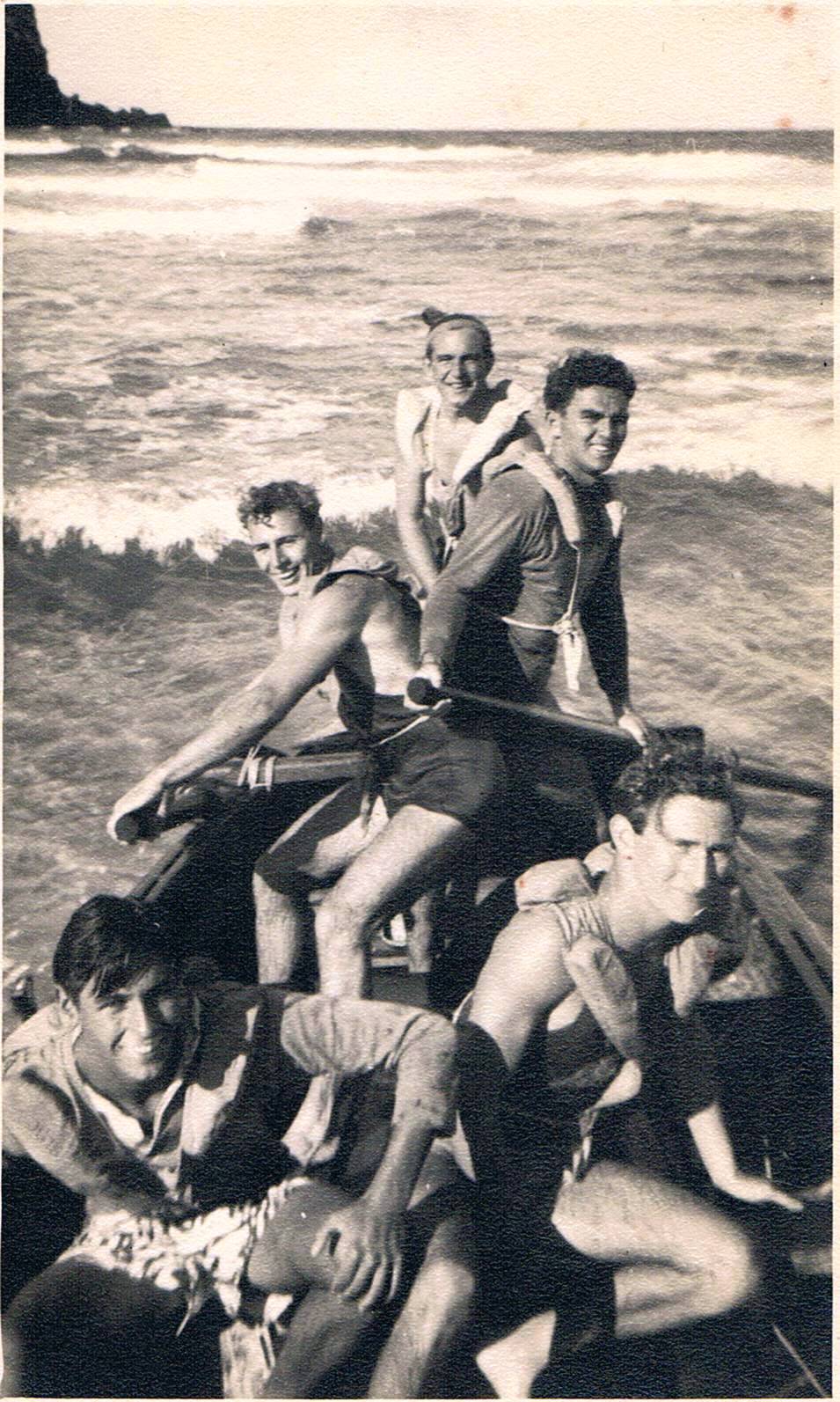
Were you a fulltime lifesaver during the war?
No, there weren’t any as far as I’m aware, none at all, in the area or the northern beaches.
Records show there were a lot of people on Sydney beaches during WWII, not just American soldiers sent to Australia for leave, for supplies and training - residents guarded potential coastal landing places, the Air Training camp in Ruskin Rowe; who allowed the Club to purchase one of their Huts from the Air Force in 1945. This was placed adjacent to the northernmost wall of the clubhouse and used by members on weekends and holidays and a boon in post-war scarcity. It was around this period that plans for an extension and/or new clubhouse were raised once again. The hut may have been a stopgap with no materials and few funds available.
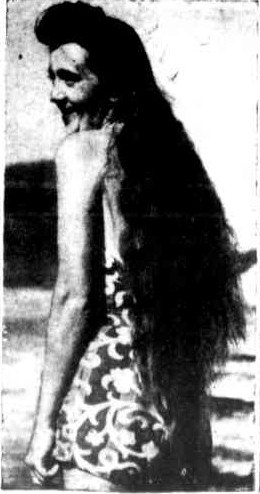 Surf rescues and treatment of cases of collapse and shock at the beaches kept life-saving and ambulance officers busy yesterday.
Surf rescues and treatment of cases of collapse and shock at the beaches kept life-saving and ambulance officers busy yesterday.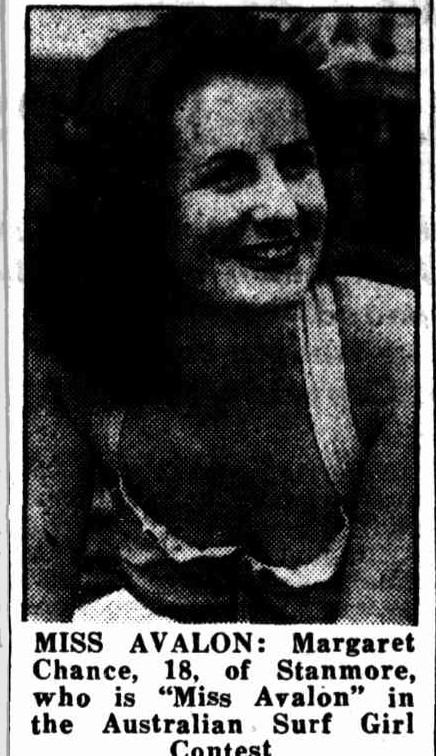

Left to right: Jim Campbell, Max Watt, Brian Sheehan, Geoff Gearside and Max McCredie. Photo: courtesy Norma Watts (RIP)
Lifesavers Catch Huge Shark
Avalon lifesavers yesterday caught a 12ft 800lb whaler shark which had been cruising off the beach during the holidays. It was caught on a line set from a buoy. Five lifesavers in a surfboat tied the line to the boat and, after fighting with the shark for half an hour, caught a wave to the beach. The shark had a two-foot jaw span. The surf club exhibited it in a marquee. They collected £7 in donations, and then sold the shark as shark steak. The whaler is one of the species of Australian sharks known to attack humans. The North Narrabeen club used shark repellent at their surf carnival yesterday. A boat towed a bag of copper acetate around the swimming area. No sharks were seen during the carnival. Lifesavers Catch Huge Shark. (1949, December 28). The Sydney Morning Herald (NSW : 1842 - 1954), p. 1. Retrieved from http://nla.gov.au/nla.news-article18145086
Doug Crane passed away on December 9, 2011.
Reginald C Wood, who had moved to the south coast, passed away March 8, 2021.
Doug Crane is remembered through the surf club's annual within club swim after.
The club states of Mr. Crane:
Doug was a member of Avalon Beach SLSC for 65 years having gained his Bronze Medallion back in 1946. Doug was saving lives on our beach well before rubber ducks, rescue boards, wetsuits and tubes. A rescue then meant swimming out attached to a heavy belt and line, something at which Doug excelled, being the Junior Belt Race champion in his first year and then the Senior Belt race and Senior Swim Champion for three years running a couple of years later.
Over the years Doug was a driving force within the club holding the Club Presidency from 1977 – 1989, an incredible 12 years, only almost matched since by Warren Young 1990-2001. He was also the Club’s Vice Captain, Patrol Captain, Registrar, a Life Membership Committee Member and Club Delegate to Branch.
Doug was awarded Life Membership of the Club in season 1982/83 and awarded the Club Honour Blazer in season 2005/06. In the 1995-96 season he was one of four to be awarded the first 50 Year Service Awards (along with Max Watt, Reg Wood, and Ken Davidson). In 1999 he received the Commonwealth Recognition Award for Senior Australians.
In 2003-04 Doug, then in his 70’s, finally decided to retire from patrols and the last Sunday swim for the year was renamed The Doug Crane Classic. In 2005-06, Doug received the 60 Year Award. In 2008 Doug received the Surf Life Saving Sydney Northern Beaches Distinguished Service Award.
In the 100th year celebrations of volunteer members of Avalon Beach SLSC serving others on this beach, where the boom of a rising surf can itself sound like distant battle when those waves meet the shore, the enlistment of active patrol members, and the loss of so many of them during their service, is worth remembering this VP Day.
Avalon Beach RSL Cenotaph has pavers with their names and shares in what capacity they served during this conflict, as well as residents who have served Australia in other conflicts.
Avalon Beach SLSC also honours those who served, not just with an Honour Board, but with Norfolk Pines and this annual event which celebrate the loves and strengths of those who served the cause of peace in whatever capacity they could and in turn, shaped the community we now live in.
Some of these people we may never know, and never hear their voices - but their spirit lingers still in these green hills and over these beaches, inspiring us all to do what we can, whatever that may, to honour community and their legacy.
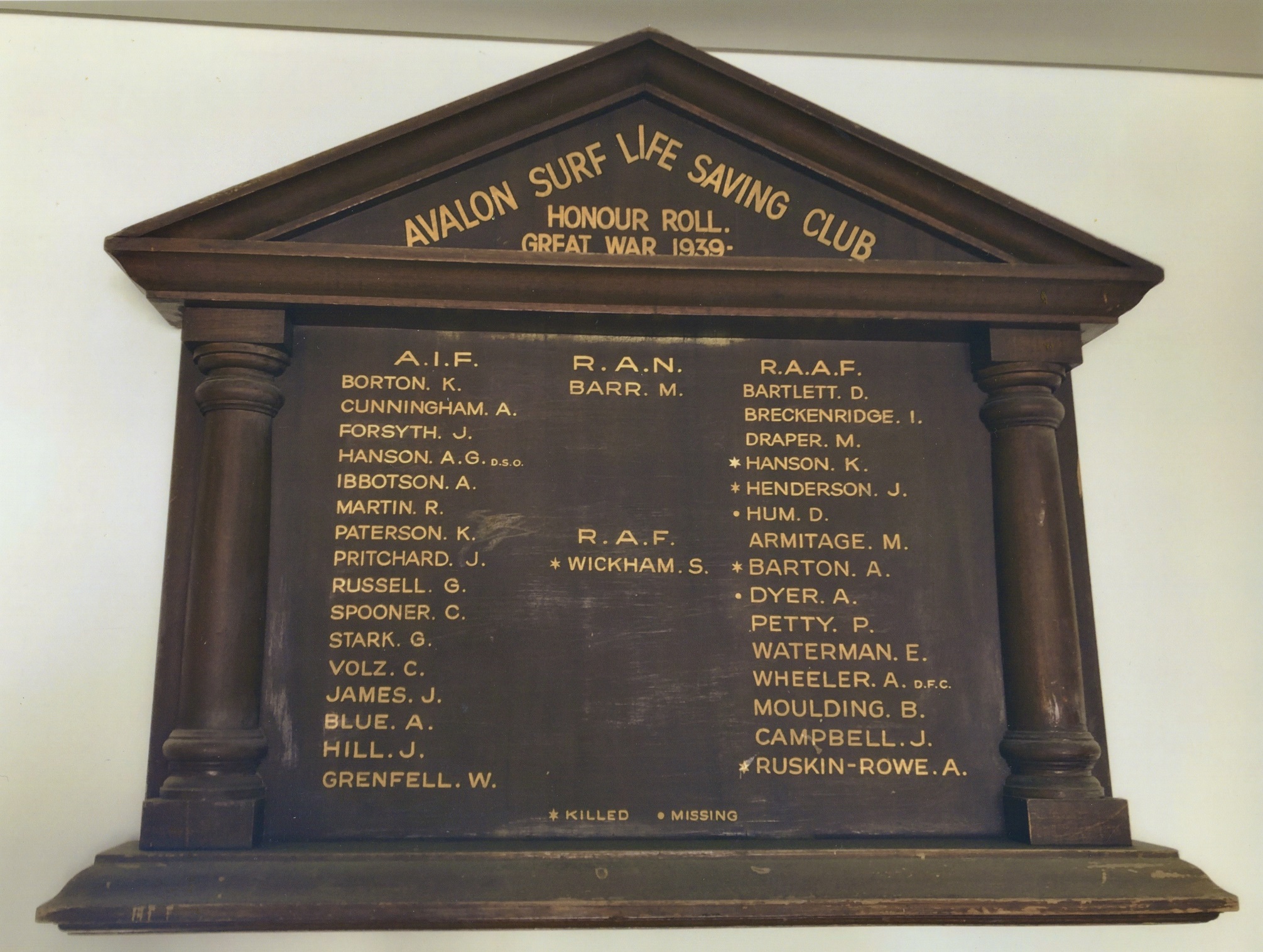
Avalon Beach SLSC Honour Board for WWII, shows five lost their lives serving in this conflict. Photo: Geoff Searl OAM

Hurley, Frank. (1910). View through trees of Avalon beach and headland, 1950's, New South Wales Retrieved from http://nla.gov.au/nla.obj-160158036 -:
References - Extras
- TROVE - National Library of Australia
- VP Day 2019: Anthony Thomas Ruskin Rowe, Spitfire Pilot (1919 To 1943) - Who Defended Darwin and His Mate: An Avalon Beach and Pittwater Hero
- Opportunity to Visit Submarine War Grave Renews Memories of 75 years ago - July 2017 History pages
- Pittwater's Midget Submarine M24 War Grave Renews Memories Of 75 Years Ago - August 2020
- Mona Vale SLSC: The Clubhouses - Some history
- Broken Section: The Story Of Pittwater's Anti-Submarine Boom Net By John Illingsworth
- Coastal Defences In World War Two: The Dee Why to Warriewood Sections
- Traces Of WWII Coast Watchers (1942) Found On Bangalley Headland After Recent Fire
- The Mona Vale-Bungan Beach-Bayview tank traps: Coastal Defences of Pittwater during World War Two - Some History
- Pittwater Summer Houses: The Cabin, Palm Beach - The Pink House Of The Craig Family
- Mona Vale Training Grounds: From Lancers on Horses to Lasses on Transport Courses
- Brock's The Oaks - La Corniche From 1911 to 1965: Rickards, A Coffee King, A Progressive School, A WWII Training Ground
- Bruce Robertson OAM - Profile
- Reginald Charles Wood (Reg) - Profile
- Douglas Crane - Profile
- Lindsay Dufty, WWII Veteran - Remembrance Day 2023: Darwin, February 19, 1942 Profile
- Perfect Send Off For Two ABSLSC Club Legends - Life Members Reg Wood And Don "Imo" Imison - 2022
- Avalon Beach SLSC 90th Anniversary Exhibition and Celebrations May 1-3, 2015
- Avalon Beach Norfolk Pines: to Honour those who served – Anzac day 2023 history precursors
- Doug Crane Classic Celebrates Its 20th Year: The History Of This Great Swim - 2023
- Avalon Beach Surf Life Saving Club - The Second and Third Clubhouses
The HANSON BOYS
 Three sons were born to Sydney dentist, Arthur Cecil Hanson and his wife Mildred Blanche Faviell. Arthur George Hanson (known as ‘Tom’ to most) was first born at Hunters Hill in 1911. Geoffrey Faviell Hanson followed in 1914 and Kenneth John Hanson completed the family.
Three sons were born to Sydney dentist, Arthur Cecil Hanson and his wife Mildred Blanche Faviell. Arthur George Hanson (known as ‘Tom’ to most) was first born at Hunters Hill in 1911. Geoffrey Faviell Hanson followed in 1914 and Kenneth John Hanson completed the family.
Prior to 1920 Arthur bought a block of land on the corner of Avalon Parade and Ruskin Rowe on which he built a two-room cottage. It consisted of a bedroom and a kitchen/dining room but both were surrounded on 3 sides by a generous open verandah where later children of the families spread their mattresses and camp beds. He called the cottage ‘Keilor’ after the north-west suburb of Melbourne from where Blanche’s family hailed.
The family spent considerable time at ‘Keilor’ travelling down from Hunters Hill and later Killara in Arthur’s bull-nosed Hupmobile.
The 3 boys loved the water and decided to join the surf club. In the photo taken in 1925 of the meeting on the steps of ‘Avalon’ which resulted in the formation of the Avalon Beach SLSC, Dr Hanson is standing on the steps alongside A .J. Small, the owner and developer of Avalon Beach.
A.G. (Tom) and Geoff were in the same successful Bronze Medallion squad on 7 April 1935 (the Club’s 2nd squad). The 3rd brother Ken obtained his Bronze Medallion with the Club’s 3rd squad on 29 March 1936. Geoff gained the Club’s 2nd Instructor’s Certificate with the 4th squad which passed on 31 January 1937. Geoff became Club Captain one year later and it is recorded that he held a card night at the home which raised 6 pounds which went to the new boat under construction (launched on 4 December 1938). Geoff served as Hon. Treasurer in 1939 and rowed competitively in the new boat under the new Boat Captain and Sweep, Gordon Brown.
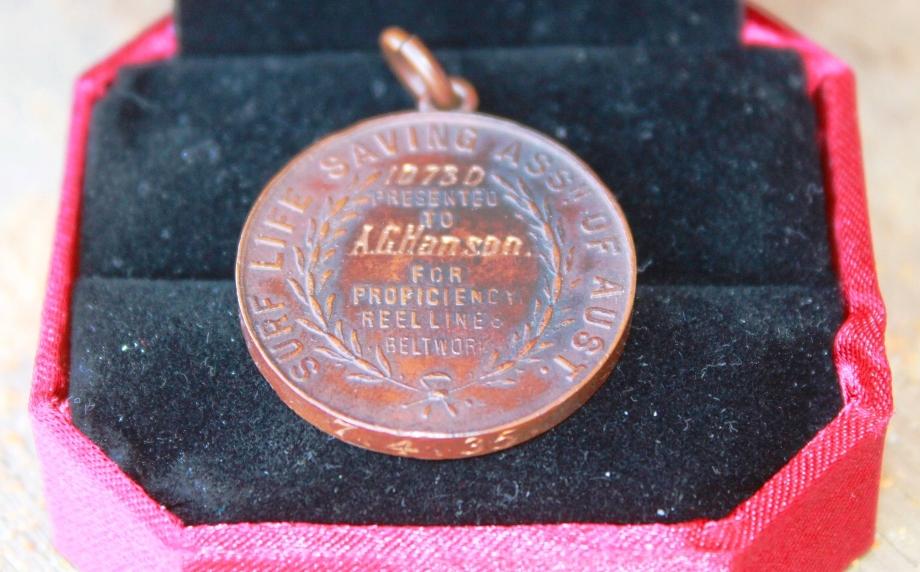
In November 1939 Tom Hanson was among several members who left to join the AIF. The last of the Club’s Active Members to leave was Ken Hanson when he joined the RAAF in January 1941.
Dr Hanson died in 1935 and so never knew of the death of his youngest son Ken who perished when his Liberator bomber was shot down over Celebes (Sulawesi) in 1945. Geoffrey died in 1976 but it was Tom the eldest son who kept the Hanson flag flying.
In November 1942 F Troop was flown into Popondetta under the command of Major Hanson. He was nicknamed Black Tom, while the battery’s code-name was Blackforce.
After the war he joined the CMF reaching brigadier in 1957 when he was commander of the artillery’s 2nd Division. He died in Sydney in 1999 at the age of 87.

Above: A.G. (“Tom”) Hanson in full regalia as A.D.C. with his DSO and Bar medals
Arthur George Hanson: Service Number: NX144
Rank: Captain
Unit: 2/1st Field Regiment
Service: Army
Conflict: Second World War, 1939-1945
Award: Mention in despatches
Date of London Gazette: 30 December 1941
Location in London Gazette: Page 7358, position 91
Arthur George Hanson: Service Number: NX144
Rank: Major
Unit: 2/1st Field Regiment
Service: Army
Conflict: Second World War, 1939-1945
Award: Distinguished Service Order
Date of Commonwealth of Australia Gazette: 23 December 1943
Location in Commonwealth of Australia Gazette: Page 2798, position 5
Date of London Gazette: 23 December 1943
Location in London Gazette: Page 5574, position 14
Arthur George Hanson: Service Number: NX144
Rank: Lieutenant Colonel
Unit: 2/1st Field Regiment
Service: Army
Conflict: Second World War, 1939-1945
Award: Bar to Distinguished Service Order
Date of Commonwealth of Australia Gazette: 6 March 1947
Location in Commonwealth of Australia Gazette: Page 745, position 10
Date of London Gazette: 6 March 1947
Location in London Gazette: Page 1089, position 17
G. Wray, late of the A.I.F., and newly-elected honorary secretary of the Mona Vale Club, was elected to the executive of the association. Surf Life-saving SHARK RESCUE AT FORSTER (1944, April 5). The Sydney Morning Herald (NSW : 1842 - 1954), p. 10. Retrieved from http://nla.gov.au/nla.news-article17889708
PUPIL RESCUES INSTRUCTOR
Constable Swept To Sea
- SYDNEY, Monday.
Constable Russell Crook (26), instructor of the Police Boys' Club surf rescue teams was carried to sea at at North Steyne yesterday. He was rescued by one of his pupils, Harold Kearslake, aged 20. Fortunately, the current was not strong at the time. PUPIL RESCUES INSTRUCTOR (1941, July 21). The Armidale Express and New England General Advertiser (NSW : 1856 - 1861; 1863 - 1889; 1891 - 1954), p. 4 (FINAL EDITION). Retrieved from http://nla.gov.au/nla.news-article192557831
CONSTABLE IN HARBOR RESCUE
A police constable dived from a Manly ferry yesterday to rescue a man who had fallen overboard. The rescued man is John Leahey, 48, of Harris street, Pyrmont. Leahey fell over the side of the Manly-bound ferry Barrenjoey, near Garden Island, about 4.45 p.m. Constable Russell Crook, of Clarence Street, who was a passenger on the ferry, told the master of the vessel. As the ferry approached Leahey, Crook removed his coat and shoes and dived in. He supported Leahey with the aid of a lifebelt which other passengers threw to him. A launch from Garden Island picked up the two men and transferred them to the ferry. At Manly Police Station, police charged a man with drunkenness. CONSTABLE IN HARBOR RESCUE (1946, October 11 - Friday). The Daily Telegraph (Sydney, NSW : 1931 - 1954), p. 1. Retrieved from http://nla.gov.au/nla.news-article248405022
IT'S CROOK HE CAN SWIM!
REMEMBER Constable Russell Crook, the handsome secretary of Police Boys' Clubs, Clarence-street Division?
I sang a little song to you all a while back in praise of his wonderful kindnesses to homeless dogs and kids.
Russell is the boy who dived off Manly ferry midweek and held up a man over-board until the fishing fleet arrived to haul them out of the drink.
So yesterday I phoned him for a story, and it seems there is nothing to tell . . . not a darned thing even . but my! that boy has a nasty suspicious mind:
"Look here, Miss," he said (drawing my attention to the fact In the kind of voice Sgt. Koop used when I hit him on the head with a golf ball), "You're not putting anything in the paper, are you?" ' .
"Why, Constable," I cried, all hurt like . . . "How can you imagine such a thing."
So you see, bub, the guy won't talk,
But just catch his steely eye when it has that "Help the Anti-TB Clubs" gleam in it, and he'll fix you like the ancient mariner and become No. 1 ear-basher-in-chief . . . Nice bloke. Getting around (1946, October 13). The Sun (Sydney, NSW : 1910 - 1954), p. 17. Retrieved from http://nla.gov.au/nla.news-article229557021
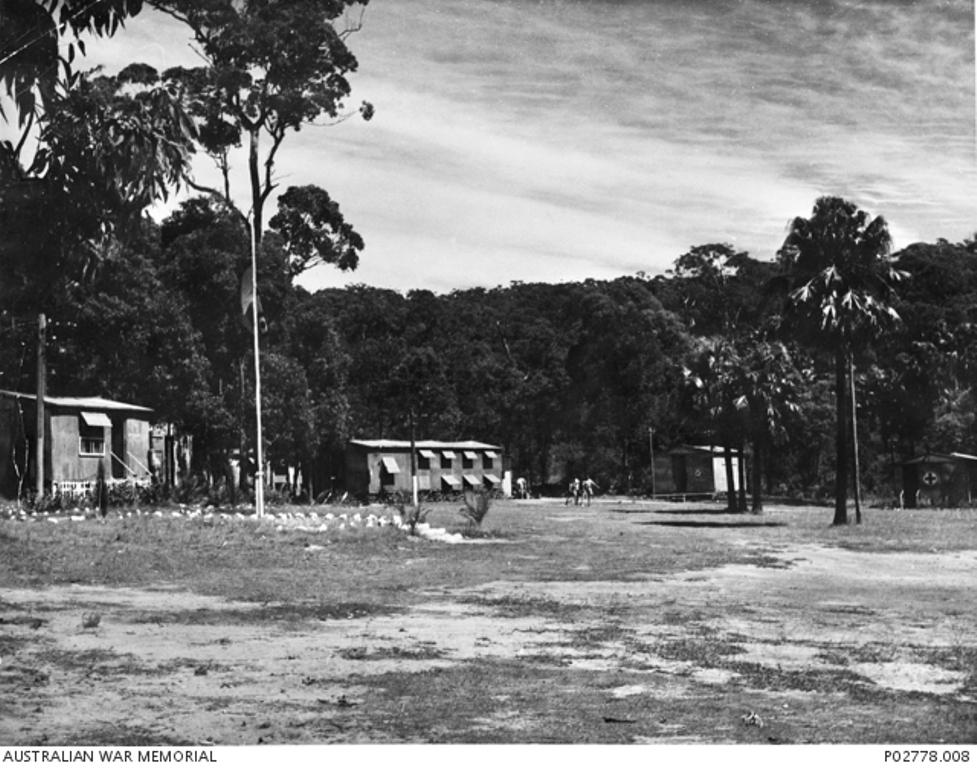
The ATC Camp in Ruskin Rowe during WWII:
How A. T. C. Trains Fledglings Far Future Service In The Air
Nowadays when a rookie enters the R.A.A.F. it's two to one that he enters with a good idea of what to expect in the Service. Not only has he done preliminary training in technical subjects, but he's well primed on Service routine, down to details like folding his blankets in the miraculously neat Service manner.
HE knows all about such Service mysteries as substantive, temporary, and acting ranks, and he can talk glibly in that language of initials so beloved of the Services, and so maddening to female companions.
All this is due to the Air Training Corps-for boys between 16 and 18 - which has supplied 5000 R.A.A.F. enlistments for the Commonwealth, and which keeps up a steady flow of the Service intake. Recently one month's figures showed that 70 per cent, of the in-take for air crew was drawn from the A.T.C. Permanent camp
AT Avalon, N.S.W., there is a camp for these lads. The Avalon camp is the only permanent A.T.C. camp in Australia, and has an ' R.A.A.F. staff. A steady flow of .A.T.C. squadrons from all over the State passes through this camp, each group spending a week.
When the boys go into this camp, with its Service-style huts set in a glade among cabbage palms and flowering gums, and within a mile of th»- sea, the first thing they're told is that this week isn't going to be a holiday.
They find their day lasts from 6 a.m. to 10.30 p.m., that it follows closely the routine of physical training, study, and fatigues that they'll have when they enter their R.AA.F. rookie ramp.
"It isn't a loaf, if that's what you mean by a holiday," said one lad, "but it'll do me."
A smart 16-year-old sentry salutes at the entrance. He sets the keynote for a camp which, except for the youth of its inmates and perhaps just a little less formality, conforms in every respect to an adult establishment. That is, it conforms outwardly. There is the notable variation that the boys LIKE guard duty.
Once an exasperated A.T.C. instructor said to some rookies: "If you fellows don't behave I'll put you all on guard duty."
"Can we?" shouted the boys.
At sixteen, handling a Service rifle for two hours at a stretch isn't a duty-it's a pleasure.
Nor are there any provosts in the A.T.C. Officers use the honor system. It rarely fails.
Camp Commandant Flying Officer E. Wood, R.A.A.F., has served with a famous bomber squadron in Northern Australia, and saw four years' active service with the A.IF. in the last war.
The Service lectures which he gives are among the most popular of the evening series of lectures, for he has a fund of stories about famous air aces whom he has known. He tells the boys of the comrade-ship between air crew and ground staff at operational stations, and of deeds by ground staff no less gallant than those of pilots.
One of the first things the boys learn on entering camp is how to fold their three blankets and "box' them in a fourth, in Air Force style, and how to leave their huts for inspection. The sight of those huts in the morning, with knife, fork, and plate, and shining boots set out in front of the bedding is enough to arouse the envy of the mother of any average boy.
It is Sergeant C. Herbert, R.A.A.F., Warrant - Officer - Disciplinary, who teaches them these points, and is also their drill and physical training instructor.
English sergeant
SERGEANT HERBERT, Southampton-born, who can't be as young as he looks, for he was wounded four times in his service with the British Army in the last war, has a back like a ramrod. In between the wars he served on merchant ships, and in this war he has had plenty of experience drilling Air Force recruits.
In his spare time, Sergeant Herbert grows vegetables and flowers round the mess huts.
Boys from the farthest corners of N.S.W. come to this camp for a week's training during their term in the A.T.C. Some are schoolboys, while others are already earning their living and obtain holidays to join their squadron in camp. Many have elder brothers in the Air Force.
The day The Australian Women's Weekly visited the camp the occupants were of Squadron 43, which has its headquarters in Canberra. But when squadrons from the Far West come down they often include boys who have never seen a city, nor the sea, and even some who had not previously travelled In a train.
Their own A.T.C. officers accompany the boys to camp. These A.T.C. officers, many of them schoolmasters, are men who are doing a splendid job voluntarily, and have undertaken special training to fit them for the work.
R.A.A.F. sergeants are loaned to the camp to instruct in such subjects as small arms, unarmed combat, and navigation, and during the week a visit to an aerodrome, and usually a flight, is arranged as well.
Fatigues aren't more popular than in any camp, but since each boy spends only a half day on fatigues, and there is a scrupulous oversight to see that none gets more than his fair share of the "dirty work," the lads take it cheerfully. Kitchen fatigues mean plenty of assistants for the cook. Normally the cook is an R.A.A.F. corporal, but recently he has been relieved by an interesting personality in 60year-old Frank Royall. Frank Royall was chief steward in the Aurora during Sir Douglas Mawson's Antarctic expedition in 1912 to 1914, and has served with the U.S. Merchant Navy during this war.
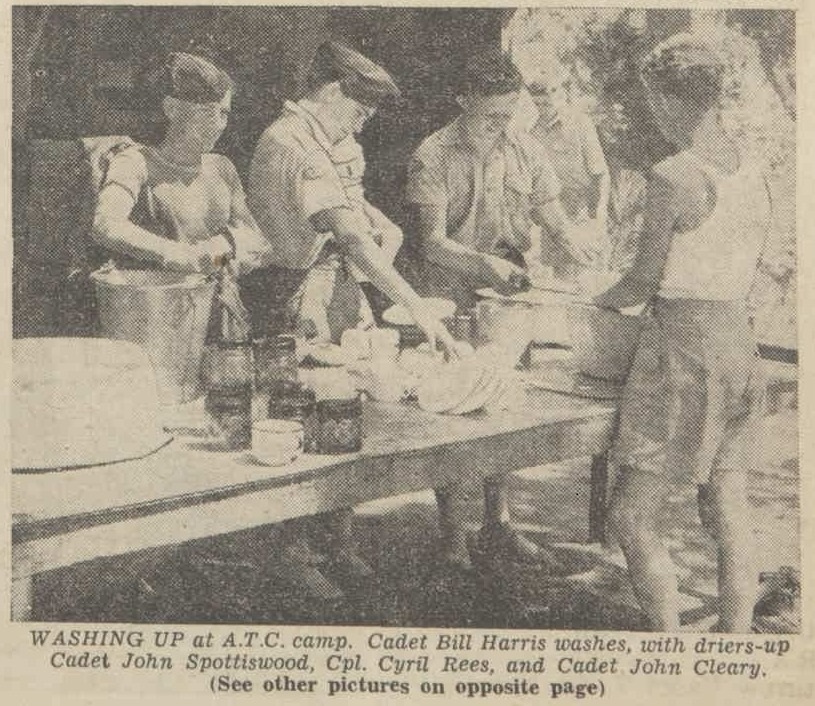
.jpg?timestamp=1615053202094)
.jpg?timestamp=1615053229444)
.jpg?timestamp=1615053255521)
.jpg?timestamp=1615053285654)
.jpg?timestamp=1615053307533)
.jpg?timestamp=1615053331537)
.jpg?timestamp=1615053365036)
.jpg?timestamp=1615053388267)
WASHING UP at A.T.C. camp. Cadet Bill Harris washes, with driers'-up Cadet John Spottiswood, Cpl. Cyril Rees, and Cadet John Cleary.
(See other pictures on opposite page)
I A.T.C. campers sample Air Force life
STATION PARADE and ceremony of raising of the ensign at Air Training Corps camp at Avalon, N.S.W. (See story of camp on opposite page.)
FIREWOOD FATIGUE. Cadets H. Burt and J. Boag saw a Iog of wood while Cadet Tom Emerson waits his turn
PEELING POTATOES. The cook, Frank Royall, shows Cadet David Benjamin how to do it, while Joe, the camp dog, looks on. Joe takes part in all parades.
UNARMED COMBAT. Sgt. T. Cowell, R.A.A.F., instructs Cpl. Ian Ray how to I throw Cadet J. Fitzpatrick.
SMART SALUTE from sentry, Sgt. Garnet Lewis, of Cess-nock, N.S.W., as an R.A.A.F. car enters the camp.
CANTEEN INTERVAL is enjoyed by Cpl. C. J. Rees, Cpl. P. J. Esdaile, Cadet A. D. Morris, and Cpl. W. A. Armstrong.
SHIP RECOGNITION is part of course. Here Flt.-Lieut. S. A. Broome, A.T.C., who is principal of Canberra Technical College, gives instruction.
ROPE CLIMB A boy of 16 15 feet, those of 17, 18,... (Pictures by A. Chambers.) How A. T. C. trains fledglings for future service in the air (1944, January 22). The Australian Women's Weekly (1933 - 1982), p. 12. Retrieved from http://nla.gov.au/nla.news-article46938279